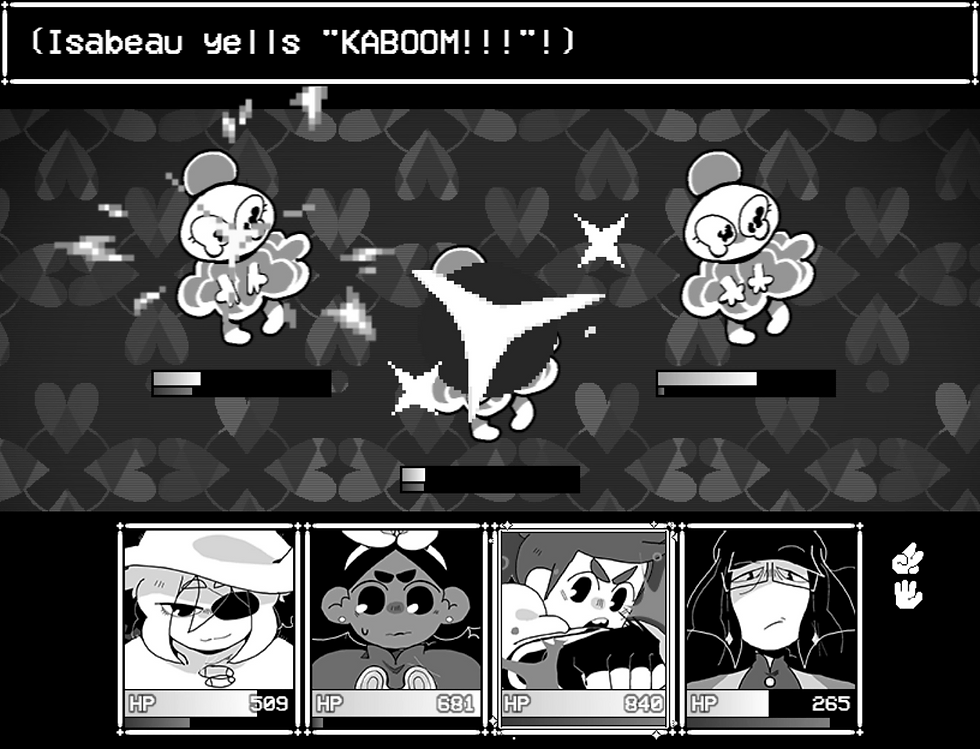"In Stars and Time" Review: A Hidden Gem with Deep Storytelling and Unique Looping Mechanics
- Roger Reichardt

- Nov 27, 2023
- 4 min read

Platform reviewed: Nintendo Switch
Also on: PlayStation 5, PlayStation 4, Steam
Price: $19.99
"In Stars and Time" is the best RPG I’ve played this year, and it certainly ranks in my top five RPGs of all time. At first glance, it's a seemingly simple presentation and battle system, but it’s one of the best narratives I’ve played in a long time. The character and world-building pulled me in right from the beginning - I fell in love with these characters and can’t recommend this game enough.

The story revolves around a group of friends who have traveled together for several months, working on collecting the orbs needed to unlock the gate to enter the evil king’s castle. The king has cast a time-freezing spell on the world - the only one to have survived this curse is Mirabelle, and the land she’s from considers her the chosen one to defeat the king. The story occurs on the eve when the group enters the castle to vanquish the king.

You’d think you’d play Mirabelle - however, the protagonist in this story is Siffrin, a lovable thief. What makes "In Stars and Time" incredible is the writing and the relationship-building that happens. I was blown away by how quickly the story and the characters drew me in. The writing is so good - each character in the party is so well-written throughout - I felt the bonds between each character and Siffrin’s tie to each one. The way that Siffrin talks with Mirabelle and has to reassure her points to her character flaws, yet she has an endearing leadership quality. Isabeau’s relationship with Siffrin is much more jovial - and the two love the play on words and witty banter. Bonnie, the child in the group, gets annoyed with Siffrin but also has a lot riding on the success of the adventure, as her sister is frozen in time. And Odile is the elder in the group - she gets annoyed with the antics of the younger adventurers. I loved how the story unfolded through the interactions with these characters and never forced exposition.

But it’s not just the characters that are created well - the world-building in the game is fantastic. Mirabelle and the people from her village believe in The Change God, and everything they do reflects their belief. Some interesting dialogue occurs when Mirabelle talks about how children from her village are given several names to encourage them to select one of the names and change as they grow. Living vicariously through Siffrin, I got to experience the culture from an outsider’s perspective.

An interesting mechanic is introduced relatively early in the game and is one of its central tenets. When Siffrin dies, I’m taken back to the beginning - yet Siffrin knows about their death and the story as it unfolded. What’s fascinating is that I could select different options in the next playthrough and see different reactions than the first time the event took place. Of course, Siffrin acknowledges different outcomes and realizes they can change the course of time. While this could be a frustrating mechanic, going back to the beginning every time Siffrin dies, the game handles it quite nicely, allowing me to continue from the last safe spot. Siffrin gets to keep all the levels and experience they gained during the run, but the rest of the characters are set back to the last save. However, if a character learns a new craft and Siffrin dies, they get to keep that new craft, even if their level had reset to a lower level than when the craft was acquired.
The battle system is simplistic at its core but is much more complicated than at first glance - it’s entirely built around rock, paper, scissors. Each character has its primary type - a few characters, like Odile and Mirabelle - start with some crafts (spells) that allow them to cast a different attack type. A tutorial walks through how to tell if the enemy is either rock, paper, or scissors - there’s a simple tell when you see the enemy. However, there may be times when the enemy doesn’t show a tell. I quickly learned the enemy’s type in these cases based on whether my characters' attacks landed. Depending on the situation, landing five of the same kind of attack in a row unleashes a special attack or resurrection. To get that to happen, I sometimes had to give up a character’s turn to someone else to land five of the same attacks in a row.

Similar to other turn-based RPGs, the enemies can be seen walking around the dungeon floor. There were times when I did my best to avoid detection - other times, I was full of health, and I wanted the encounters to level up my party. Final Grade: A+ I love "In Stars and Time" - it appears to be a simple RPG at first glance. The game is all in black and white. There’s nothing flashy about the presentation. The battle system is based on rock, paper, and scissors. But digging into the game, it’s soon apparent that there’s a lot of depth here. The story, the character, and the world-building absolutely won me over. The looping mechanic is interesting and could be a real hindrance to the game if not implemented correctly. But so much love and attention went into this game - everything works perfectly together. "In Stars and Time" is a hidden gem - for those new to RPGs, this is a great game to start with. And seasoned veterans in the genre will appreciate the deep storytelling, looping, and battle mechanics.







Comments